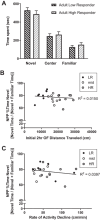Locomotor Response to Novelty: What Does It Tell Us?
- PMID: 39935251
- PMCID: PMC11814917
- DOI: 10.1002/dev.70024
Locomotor Response to Novelty: What Does It Tell Us?
Abstract
Individual differences in response strategies may be utilized to identify those at risk for the development of neuropsychiatric disorders such as depression, anxiety, and substance use. One behavioral attribute that has been used to predict later mood disorders and substance use disorders is an organism's predisposition for novelty-seeking, modeled in rodents as increased exploration of novel environments or stimuli. Despite documented correlations of locomotor response to a novel environment and disease-specific tendencies, it remains unclear whether the "response to novelty trait" is stable across time and environments. Adolescence is an important transitional time, associated with vulnerability for neuropsychiatric disorders. Only a few studies have assessed whether variations in novelty-seeking behaviors in adolescent animals translate to variations of susceptibility to neuropsychiatric disorders later in life, and it is unclear whether initial locomotor responses to novelty are stable across time and development. We examined whether locomotor response to a novel environment is a stable attribute across time in a series of Open Field tests in early adolescent (postnatal day [p] 23-25) late adolescent (p58-59) and adult (p72 and older) male Sprague-Dawley rats. We also examined the relation between the locomotor response to a novel environment and other measures of responding to novelty. Results suggest that locomotor response to a novel environment does not emerge as a stable behavioral attribute until late adolescence. They also suggest that locomotor response to a novel environment and novelty-seeking, as assessed with the Novelty Place Preference paradigm, capture nonoverlapping behavioral tendencies.
Keywords: adolescent; early experience; habituation; locomotion; rodent.
© 2025 The Author(s). Developmental Psychobiology published by Wiley Periodicals LLC.
Conflict of interest statement
The authors declare no conflicts of interest.
Figures






References
-
- Arenas, M. C. , Daza‐Losada M., Vidal‐Infer A., Aguilar M. A., Miñarro J., and Rodríguez‐Arias M.. 2014. “Capacity of Novelty‐Induced Locomotor Activity and the Hole‐board Test to Predict Sensitivity to the Conditioned Rewarding Effects of Cocaine.” Physiology & Behavior 133: 152–160. 10.1016/j.physbeh.2014.05.028. - DOI - PubMed
MeSH terms
Grants and funding
LinkOut - more resources
Full Text Sources

